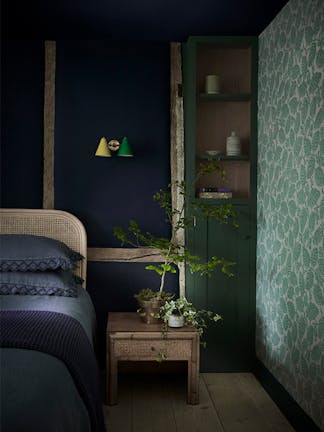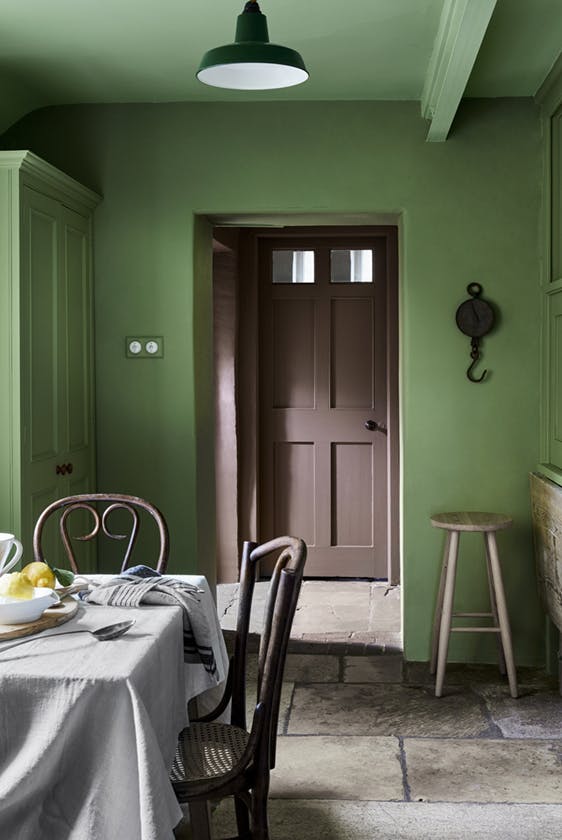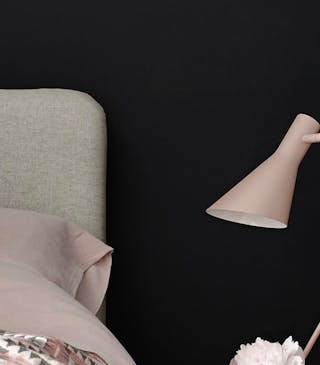Interior lighting can have a profound effect on the look and feel of your space. From discreet wall lights to statement shades and fittings, the lighting you choose should be a major consideration when designing an interior scheme.
Just as the orientation of your room should inform which colours you choose, interior lighting can affect the way colours appear in a space.
Find inspiring ways you can use lighting to influence the atmosphere of your space, with expert insight from Hollie Moreland, Creative Director at David Hunt Lighting…
Considering lighting when selecting colours
How room orientation impacts colour
Depending on the direction your room faces, the natural light it receives is often described in terms of warmth or coolness. North-facing rooms receive cool light with little direct sunlight. Whereas south-facing spaces receive the warmest light and are bathed in sunlight for almost the entire day.
As a general rule, cool spaces can be made to feel cosier with the use of brighter or warmer shades. On the other hand, warm spaces work well with cooler neutrals, blues or green tones.
Explore our guide to considering the orientation of a space.

Ceiling: Julie’s Dream, Left Wall: Masquerade – Mid, Right Wall: Masquerade, Panelling: Masquerade – Light

How to complement room orientation with artificial lighting
Although artificial lighting has a different effect on colour than natural sunlight, the lighting you choose for your space is a key thing to consider. You can use lighting to create a sense of balance and achieve a cohesive finish.
Hollie suggests: “As north facing spaces can be darker, they benefit from a layered approach to lighting. South facing spaces are naturally bathed in warmer light and can withstand cooler bulbs and fewer lighting sources.”

Walls: Vulcan, Window Sill, Bath & Floor: Livid

Complement your south-facing room with bright, whiter lights alongside rich green shades like Garden or Obsidian Green. In a north-facing space, you could try to inject a cosy feeling with warm, earthy shades. Try red hues like Masquerade or Tuscan Red and amplify the cosy effect by choosing lighting to create an ambient setting. Hollie adds: “As well as opting for warm LED bulbs, consider adding additional sources of light to north facing rooms, such as up lighters and wall lights.”

Lower Wall: Tuscan Red, Upper Wall: French Grey, Ceiling: French Grey – Pale

Sample paint colours in situ in natural and artificial light
To find out how a particular colour will appear in your space, it is vital to sample paint colours in situ.
Hollie writes: “A warmer light bulb will give a warmer tone which will have an impact on the colours in your design scheme. Consider the time of day you use the room. Will you be using it during daylight hours or with your lights on, or both?
To test the effect of your lighting on paint colours, always view your samples with and without your lights on and at different times of day. This will give an accurate view on the effect of your lighting on colour choices.”
Paint out sample pots in your selected shades onto A3 pieces of card or lining paper. View them in your space throughout the day, in both natural and artificial light, to confirm your colour choices. Test the painted samples alongside your chosen lighting, so you can see exactly how the colours will appear.
For more advice on sampling paint in your home, read our helpful guide.

Upper Wall: Stock, Panelling: Travertine

Choosing lighting for different spaces
Whether classic or contemporary in style, different lighting solutions are a fantastic way to harness the character of your scheme and develop a distinctive mood and atmosphere. Hollie Moreland, Creative Director at David Hunt Lighting, shares how lighting can create beautiful, comfortable settings in different parts of the home.
Layer lighting for a cosy bedroom scheme
Layering is one of the best ways to develop a cosy feel in a space. For a restful bedroom, layer different textures, accessories and other interior design elements, including lighting.
Hollie writes: “Bedroom lighting schemes can be tricky as the space is used at different times of the day and therefore requires versatile, layered lighting to give flexibility. Lighting in bedrooms should offer both a restful, cosy feeling for evenings and a brighter environment for getting ready in the morning.
As well as finding bedroom lighting designs to suit, it’s vital to choose the right bulbs. Look for an LED bulb with a warm, soft glow for bedside lights. This will ensure you have enough light to read by, without interrupting your sleep pattern.”

Walls: Basalt, Stool/beside table: Orange Aurora

Wallpaper: Fern - Off Black, Bed: Middle Buff
Basalt is a timeless blue-black that provides an impactful backdrop with a cosy, cocooning quality. For a cohesive feel, make sure to integrate the colour of your lighting within the wider scheme. Choose a contrasting coral lamp and pair with soft light pink bedding and accents of Orange Aurora.
Introducing a botanical wallpaper is a great way to add more texture and evoke the calming qualities of nature. Pair Fern – Off Black with a textured lampshade to create ambient lighting and shadows.

Hollie suggests: “Wall lights are a wonderful solution for bedside lighting as they free up space on your bedside table and are easier to direct for reading. Consider an articulated design which can add a beautiful decorative touch as well as being perfect for reading in bed. Consider a painted finish that coordinates with your walls. I always find deep greens and midnight blues very relaxing, making them perfect for elegant bedside lighting.”
Create a contemporary bedroom scheme using wall-mounted accent lighting. Use Beech Nut – Rubine alongside dark Dock Blue walls with small wall lights in bright accent colours.
Use statement lighting to add wow factor to your dining space
Dining rooms are some of the most sociable areas of the home. So it’s important to think about how you can create a welcoming atmosphere. Using a statement light is a wonderful way to draw attention to the most important feature – the dining table.
Hollie writes: “I love statement lighting pieces. The obvious choice is a wonderful oversized central piece that makes the most of your room’s proportions. However, impact doesn't have to be based on a singular large light. You can cluster together smaller pendants to create an equally dramatic look.
Proportions in a room are a key factor in choosing lighting that makes a statement. Ceiling height must be considered when choosing large pieces.”

Far Wall: French Grey - Pale, Right Wall: Portland Stone - Dark, Woodwork: French Grey - Pale, Chairs: Sage & Onions
For a well-balanced feel, carefully consider where you want the focus of your dining room scheme to be. If your scheme is neutral, choose a brightly coloured pendant light that coordinates with your table and chairs. Complement French Grey – Pale walls with a green drop light and paint your dining chairs in the vibrant green, Sage & Onions.
Hollie says: “Playful, colourful designs will add joy and personality to a dining space. David Hunt Lighting Scallop Pendant Lights with their wavy edge and contrasting colours are a fabulous solution for adding a statement piece over dining tables or kitchen islands. Available in bespoke options, you can create a unique finish in your favourite Little Greene colours.”

Wall & Ceilings: Windmill Lane, Kitchen Units: Córdoba

Ceiling: Flint, Walls: indian Yellow, Skirting: Hopper
Create focus in your kitchen with bright lights
While most areas of the home benefit from warm, layered lighting, kitchens are fast-paced settings which are suited to brighter lights. It’s important to have good lighting that illuminates your workspace as you prepare and cook meals. A pendant task light will create focus as well as looking sleek and sophisticated in the space. Balance the bright white light with stronger paint colours to reflect the energetic feel of a family kitchen.
When it comes to choosing a pendant light, there are a number of practical considerations. Hollie suggests: “Always check a pendant’s minimum height to ensure easy head height clearance as well as the maximum height. If the light is supplied with a chain, check it’s long enough for your desired position or enquire about bespoke options for extending the overall height.
The level of light output can also be used to create impact and make a statement. Your desired light output can impact the choice of fitting you opt for, and the number of bulbs a piece delivers. Before you select, consider which element of the lighting you want to achieve the statement; colour and finish, scale and size, strength of light or a combination of these.”
Upper Wall: Aquamarine - Pale, Lower Wall: Aquamarine - Mid, Island: Aquamarine, Worktop: Livid
Use shades from the Aquamarine family of tranquil green-blues and incorporate a black pendant light for a contemporary accent. For something a little bolder, use the mid-strength green, Garden, on walls and woodwork with Pea Green on the ceiling. Choose a statement green ceiling light that blends with its surroundings for an uninterrupted, wrap around feel.
Find more inspiration in our guide to choosing kitchen paint colours.

Ceiling: Pea Green, Walls: Garden, Larder Cupboards: Garden, Far Walls: Scullery, Door: Scullery
If you’re struggling to choose lighting for your home, one of Hollie’s best tips is to opt for dimmable lighting.
“It’s not just the lighting you choose, but how you use it that can create impact. Having dimmable lighting is the best way of controlling the effect lighting has in a room. It allows you to create different moods and emphasise different areas within a space. For me it’s an absolute must-have.”
Browse our image gallery for more interior and lighting inspiration.
Or discover more lighting ideas and solutions from David Hunt Lighting.


